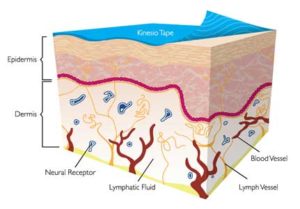
Taping therapy
Like the ashiatsu massage in China, taping therapy – also called neuromuscular bandage – is used regularly for training ; prevention and rehabilitation in high-level sports.
Taping is a complementary supportive therapy that helps Olympic athletes to reduce pain and facilitate healing of their muscle tissue while allowing them to maintain range of motion without having to use prohibited medications or pain relievers.
While taping helps resuscitate or develop the careers of athletes who have often suffered series of injuries due to the intensity of their training, it is now used in massage therapy to support; treat and relieve muscle and joint pain for all who can benefit from it.
![]()
Elastic cotton adhesive strips (waterproof membrane but allowing evaporation) which are stretchable from 10% (base tension of the strip) to 100% (maximum tension when the strip is pulled) are used. They are applied to targeted muscles, ligaments, tendons and joints that need support and / or are painful.
This natural method lies between the elastic bandage and the plaster cast. Instead of completely blocking the joint treated like a cast, the taping can be worn while allowing an excellent range of motion during sports training or work.
It can be used comfortably while showering, swimming and for all activities of daily living.
The tension exerted by the bands slightly lifts the skin and generates convolutions, small waves that separate connective tissues and facilitate and stimulate better blood flow to the area being treated.
![]()
Taping causes four positive effects:
1. Decreased pressure on subcutaneous mechanoreceptors.
Mechanoreceptors are small neurological receptors, located under the skin, that send a pain signal to the brain when they are too compressed.
By lifting the skin, taping therapy releases these receptors, which stops them to send a pain signal to the brain.
2. Improved lymphatic and blood circulation.
When there are muscle contractures, you can think of tense skin as a foot pressing against a garden hose, reducing the flow of water.
Thus, when lifting the skin, as if lifting the foot on the garden hose, in this case the “lymphatic channels”, the arteries and the veins, are less compressed and the lymphatic and blood flow is increased, which promotes faster healing of the treated structure.
3. Optimization of joint function.
Firmly guiding the joints by holding them with the bands, or by supporting ligaments, tendons or muscles, the joint is less strained and can work in a natural and balanced way.
Thus, the taping bands allow the return of homeostasis, that is to say of the overall balance of the body.
4. Action on different structures.
Thanks to its different cutting and laying techniques, taping can adapt to all structures and treat them specifically.
Thus, these bands have a therapeutic action on ligaments, tendons, muscles, joints, fascias and skin.
Taping therapy is effective in relieving tissue pain and muscle contractions. It protects a weak or injured joint (knee, ankle, shoulder, elbow), which promotes healing of ligaments without having to practice a complete cessation of activities.
The taping bands do not use any medicinal substances and have no side effects except mild skin irritation if worn for more than 72 hours. Normally, they can be effective for 3 – 5 days.
![]()
At Clinique Zen Ashiatsu the taping therapy is a complementary method combined with laser therapy or massage.
Contraindications:
acrylic allergy
open wounds
healing scars
skin infection such as psoriasis or eczema
no taping on the sacrum of pregnant women during the first three months of pregnancy
Click “Réserver” To book the Taping Therapy online :

